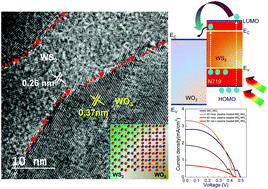Plasma driven nano-morphological changes and photovoltaic performance in dye sensitized 2D-layered dual oxy-sulfide phase WS2 films
Abstract
The present work examined dye sensitized 2D layered tungsten disulfide (WS2) as a photo-anode in solar cells with no use of nanocrystalline metal oxides as electron acceptors such as titanium dioxide. It is observed that coating WS2 directly onto a fluorine doped tin oxide (FTO) transparent conductor, annealed at 530 °C, resulted in a mixed oxy-sulfide dual phase as confirmed by transmission electron microscopy and X-ray diffraction studies. Further studies on the surface morphology of the dual phase WS2–WO3 film showed a random distribution of platelets which further shaped into precisely regulated hexagonal platelets upon plasma treatment. High resolution transmission electron microscopic studies elucidated two different phases, WS2 and WO3, with d-spacing values of 0.26 nm and 0.37 nm, respectively. A well-defined grain boundary was also observed which separated the oxy-sulfide phase in the sample. The dual WS2–WO3 phase films showed optical absorption in the wavelength range of 350 nm–800 nm with a systematic increase in plasma exposure duration. Photovoltaic devices fabricated using the WS2–WO3 mixed phase photo-anodes resulted in 0.61% efficiency (η) which further was observed to be sensitive to the plasma exposure as it was observed that the 20 minute plasma treated sample increased the η value to 0.67%. Plasma treatment on the dual-phase samples orients and modifies the shapes of the platelets with a significant change in the surface which eventually influences the charge transport in resulting photovoltaic devices and thus the variation with respect to exposure duration.



 Please wait while we load your content...
Please wait while we load your content...